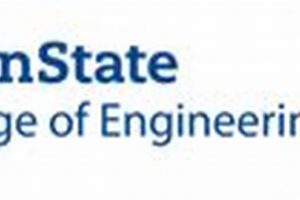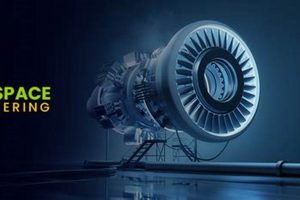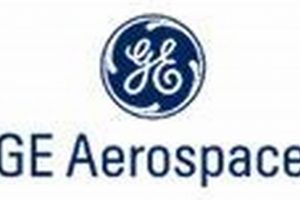This field of engineering is concerned with the design, development, testing, and production of aircraft, spacecraft, and related systems. It encompasses a broad range of disciplines, integrating principles of aerodynamics, propulsion, materials science, structural analysis, and control systems. For example, this area of study is essential in creating commercial airliners, military fighter jets, satellites, and space exploration vehicles.
Its significance lies in its contribution to advancements in transportation, communication, national security, and scientific discovery. Historically, developments in this domain have propelled technological progress, leading to faster air travel, global communication networks, and a deeper understanding of the universe. Further, it fuels economic growth through job creation and innovation in related industries.
The following discussion will delve into specific facets of this multifaceted engineering discipline, including its various specializations, the current challenges it faces, and the future directions it is likely to take.
Guidance for Aspiring Professionals
The following provides actionable guidance for individuals seeking a career within the diverse landscape of aircraft and spacecraft development. These tips are designed to enhance understanding and preparedness for a demanding, yet rewarding profession.
Tip 1: Strengthen Foundational Knowledge: A robust understanding of mathematics (calculus, differential equations, linear algebra) and physics (mechanics, thermodynamics, electromagnetism) is paramount. Regularly review and apply these principles to practical problems.
Tip 2: Develop Computer-Aided Design (CAD) Skills: Proficiency in CAD software is essential for designing and modeling aerospace components and systems. Practice using industry-standard tools such as CATIA, SolidWorks, or AutoCAD.
Tip 3: Gain Hands-On Experience: Seek opportunities to participate in design projects, internships, or research activities. Practical experience provides valuable insights into the engineering design process and exposes individuals to real-world challenges.
Tip 4: Cultivate Analytical and Problem-Solving Abilities: This field demands the ability to analyze complex problems, identify potential solutions, and evaluate their effectiveness. Practice breaking down complex problems into smaller, manageable components.
Tip 5: Enhance Communication Skills: Effective communication is crucial for collaborating with engineers, scientists, and other stakeholders. Practice writing technical reports, presenting research findings, and participating in team discussions.
Tip 6: Specialize in a Specific Area: Consider specializing in a specific area, such as aerodynamics, propulsion, structures, or control systems. In-depth knowledge in a particular area enhances expertise and increases career opportunities.
Tip 7: Stay Updated on Industry Trends: The aerospace industry is constantly evolving. Remain current with the latest advancements in technology, materials, and design methodologies by reading industry publications, attending conferences, and participating in professional organizations.
Adhering to these recommendations will significantly improve preparedness and increase the likelihood of success in this technically challenging field. Continuous learning and adaptation are critical for long-term career advancement.
The subsequent section will present a deeper dive into career pathways, including job outlook and salary expectations, within the broad sphere of this engineering specialization.
1. Aerodynamics
Aerodynamics is a cornerstone of aerospace aeronautical and astronautical engineering, governing the interaction between objects and the surrounding air or gas. Its principles dictate aircraft flight characteristics, spacecraft reentry dynamics, and the performance of propulsion systems. A comprehensive understanding of aerodynamics is thus essential for successful design and operation of aerospace vehicles.
- Lift Generation
Lift, the force opposing gravity, is fundamentally an aerodynamic phenomenon. Airfoils, the shaped surfaces of wings, are designed to generate lift through pressure differentials created by airflow. The precise shape and angle of attack of an airfoil determine its lift coefficient, directly impacting the aircraft’s ability to take off, maintain altitude, and maneuver. Modern aircraft designs heavily rely on computational fluid dynamics (CFD) to optimize airfoil shapes for maximum lift-to-drag ratio.
- Drag Reduction
Drag, the force resisting motion through the air, is a critical factor affecting fuel efficiency and maximum speed. Aerodynamic design aims to minimize drag through streamlining, boundary layer control, and optimized surface finishes. Winglets, for example, reduce induced drag by disrupting wingtip vortices, enhancing aerodynamic efficiency. Laminar flow airfoils, designed to maintain smooth airflow over a larger portion of the wing surface, also contribute to drag reduction.
- Stability and Control
Aerodynamic forces and moments govern the stability and control of aircraft. Control surfaces, such as ailerons, elevators, and rudders, manipulate airflow to generate controlled forces, enabling pilots to steer the aircraft. The aerodynamic design of these surfaces, along with the overall aircraft configuration, ensures inherent stability and responsiveness to control inputs. Unmanned aerial vehicles (UAVs) rely heavily on advanced control systems that compensate for aerodynamic instabilities and environmental disturbances.
- Hypersonic Flow
At hypersonic speeds, exceeding Mach 5, aerodynamic phenomena become increasingly complex. Shock waves, high temperatures, and chemical reactions influence airflow, requiring specialized aerodynamic analysis and design techniques. Hypersonic vehicles, such as space shuttles during reentry and experimental hypersonic aircraft, demand sophisticated thermal protection systems and optimized aerodynamic shapes to withstand extreme conditions. Accurately predicting and managing these phenomena is crucial for ensuring safe and efficient hypersonic flight.
These various facets of aerodynamics are indispensable in the development of aircraft and spacecraft. Improved fuel efficiency, enhanced flight stability, and the safe operation of hypersonic vehicles all rely on the application of robust aerodynamic principles. Continuing advancements in aerodynamic research, coupled with improvements in computational tools and experimental techniques, will drive the future of aerospace aeronautical and astronautical engineering.
2. Propulsion
Propulsion represents a critical component within the field of aerospace aeronautical and astronautical engineering, enabling sustained flight within Earth’s atmosphere and enabling movement in the vacuum of space. Without effective propulsion systems, aircraft and spacecraft are rendered immobile, negating their designed function. The development and optimization of propulsion systems directly impact the performance, range, and payload capacity of aerospace vehicles. For example, the transition from piston engines to jet engines revolutionized air travel, enabling faster speeds, higher altitudes, and greater fuel efficiency. Similarly, the development of advanced rocket engines has facilitated deep-space exploration, allowing probes and satellites to reach distant planets and celestial bodies. Cause and effect are intrinsically linked here: advancements in propulsion technology directly cause enhanced capabilities in aerospace endeavors.
The practical significance of understanding propulsion lies in its direct application to real-world problems. Designing a more fuel-efficient aircraft, for instance, requires a deep understanding of engine thermodynamics, aerodynamics, and materials science. Optimizing the thrust-to-weight ratio of a rocket engine is crucial for maximizing payload capacity and minimizing mission costs. Examples such as the development of the ion thruster, allowing for long-duration space missions with minimal propellant, and the ongoing research into hypersonic propulsion systems demonstrate the continuous pursuit of more efficient and capable means of propelling vehicles through air and space. These advancements demand a multidisciplinary approach, integrating knowledge from various engineering domains to achieve specific performance objectives.
In summary, propulsion is not merely a supporting technology but an integral and driving force within aerospace aeronautical and astronautical engineering. Challenges remain in developing more efficient, reliable, and environmentally friendly propulsion systems, particularly in the face of increasingly stringent emissions standards and the growing demand for space exploration. Continued research and innovation in this area are crucial for advancing the capabilities of aerospace vehicles and enabling future missions to further explore and utilize the environments surrounding our planet.
3. Structures
Within the framework of aerospace aeronautical and astronautical engineering, structural design assumes paramount importance. The integrity of an aircraft or spacecraft relies fundamentally on its structural components, which must withstand extreme forces, temperatures, and environmental conditions. The relationship is causal: inadequate structural design leads directly to catastrophic failure, while optimized structural design enables safe and efficient operation. An aircraft wing, for instance, must endure aerodynamic loads during flight, while a spacecraft structure must withstand the stresses of launch and the vacuum of space. This necessitates the application of advanced materials and sophisticated analysis techniques to ensure structural integrity.
The practical application of structural engineering principles in this domain is evident in various real-world examples. The development of composite materials, such as carbon fiber reinforced polymers, has revolutionized aircraft design, enabling lighter, stronger, and more fuel-efficient structures. Finite element analysis (FEA) is routinely employed to simulate structural behavior under various loading conditions, allowing engineers to identify potential weaknesses and optimize designs before physical prototypes are even built. These advanced analytical methods, coupled with rigorous testing, contribute to the safety and reliability of aircraft and spacecraft structures. The structural integrity of the International Space Station (ISS), for example, depends on carefully engineered joints and a robust frame designed to withstand the stresses of orbital flight for extended periods.
In conclusion, structural engineering is an indispensable element of aerospace aeronautical and astronautical engineering. The challenge lies in continually improving structural design to meet the evolving demands of the aerospace industry, including the development of more sustainable materials, the design of hypersonic vehicles, and the construction of large-scale space structures. Future advancements in this area will depend on continued innovation in materials science, computational modeling, and experimental testing, ultimately ensuring the safety, reliability, and performance of aerospace vehicles.
4. Control Systems
Control systems are integral to the functionality and safety of aerospace vehicles. These systems manage and regulate the behavior of aircraft, spacecraft, and related equipment, ensuring stable and predictable operation across a range of conditions. The effective implementation of control systems directly impacts the performance, maneuverability, and overall mission success of aerospace assets.
- Flight Control Systems
Flight control systems govern the attitude and trajectory of aircraft. They utilize sensors, actuators, and sophisticated algorithms to maintain stability and execute pilot commands. Fly-by-wire systems, commonly used in modern aircraft, replace mechanical linkages with electronic signals, allowing for enhanced control and improved performance. For example, flight control systems compensate for wind gusts and turbulence, ensuring a smooth and stable flight experience. The absence of effective flight control would render sustained and controlled flight impossible.
- Guidance and Navigation Systems
Guidance and navigation systems determine the position and orientation of aerospace vehicles, enabling them to reach their intended destinations. These systems employ a variety of technologies, including inertial navigation systems (INS), global positioning systems (GPS), and star trackers, to provide accurate positioning data. In spacecraft, guidance systems are crucial for executing orbital maneuvers and maintaining proper attitude. Without precise navigation, missions such as satellite deployment and interplanetary travel would be unattainable.
- Engine Control Systems
Engine control systems regulate the operation of aircraft and spacecraft propulsion systems, optimizing performance and ensuring safe operation. These systems monitor engine parameters such as fuel flow, air pressure, and temperature, adjusting operating conditions to maximize thrust and minimize fuel consumption. Full Authority Digital Engine Control (FADEC) systems, used in modern jet engines, automatically manage engine functions, improving efficiency and reducing pilot workload. Malfunctions in engine control can lead to significant performance degradation or even engine failure.
- Attitude Control Systems
Attitude control systems maintain the desired orientation of spacecraft in orbit. These systems utilize a variety of actuators, such as reaction wheels, thrusters, and magnetic torquers, to counteract external disturbances and maintain precise pointing accuracy. Attitude control is crucial for satellite communication, remote sensing, and scientific research. Without effective attitude control, satellites would be unable to perform their intended functions, rendering them essentially useless.
The design and implementation of control systems represent a significant challenge within aerospace aeronautical and astronautical engineering. Future advancements in this area will focus on developing more robust, reliable, and autonomous control systems, enabling increasingly complex and demanding aerospace missions. The continued integration of artificial intelligence and machine learning will further enhance the capabilities of control systems, leading to improved performance, increased autonomy, and reduced operational costs.
5. Materials Science
Materials science forms a foundational pillar upon which aerospace aeronautical and astronautical engineering is built. The selection, development, and application of materials are critical determinants of the performance, safety, and longevity of aircraft, spacecraft, and related systems. The unique and demanding conditions inherent in aerospace environments necessitate materials with exceptional properties, driving continuous innovation in materials science.
- High Strength-to-Weight Ratio
The demand for lightweight yet structurally robust materials is paramount in aerospace applications. Reducing weight directly translates to improved fuel efficiency, increased payload capacity, and enhanced maneuverability. Aluminum alloys, titanium alloys, and composite materials (such as carbon fiber reinforced polymers) are frequently employed due to their superior strength-to-weight ratios compared to conventional materials like steel. For example, the Boeing 787 Dreamliner utilizes a significant proportion of composite materials in its airframe, contributing to significant fuel savings. The pursuit of even lighter and stronger materials is a constant endeavor.
- High-Temperature Resistance
Aerospace vehicles, particularly those operating at high speeds or in extreme environments, are subjected to intense heat. Materials used in engine components, thermal protection systems, and hypersonic vehicle structures must withstand extremely high temperatures without significant degradation of their mechanical properties. Superalloys, ceramics, and ablative materials are commonly used in these applications. The Space Shuttle’s thermal protection system, consisting of thousands of ceramic tiles, exemplifies the importance of high-temperature resistant materials in spacecraft design. Further research focuses on developing materials capable of withstanding even greater temperatures for extended durations.
- Corrosion Resistance
Aerospace structures are exposed to a variety of corrosive environments, including saltwater, atmospheric pollutants, and rocket exhaust. Corrosion can significantly weaken structural components, leading to premature failure. Aluminum alloys are often treated with protective coatings to enhance their corrosion resistance. Stainless steels and titanium alloys are also used in applications where high corrosion resistance is required. Regular inspections and maintenance are essential to detect and mitigate corrosion damage. Advanced materials with inherent corrosion resistance are continually being developed to minimize maintenance requirements and extend the lifespan of aerospace vehicles.
- Radiation Resistance
Spacecraft operating in Earth orbit or beyond are exposed to high levels of ionizing radiation, which can damage electronic components and degrade material properties. Materials used in spacecraft structures and electronics must be resistant to radiation damage. Shielding techniques are also employed to protect sensitive equipment. Polyethylene and aluminum are commonly used as radiation shielding materials. Research is ongoing to develop more effective radiation shielding materials and to design radiation-hardened electronic components. The long-term performance of spacecraft in harsh radiation environments depends on the selection and application of radiation-resistant materials.
In summation, materials science plays a pivotal role in the advancement of aerospace aeronautical and astronautical engineering. The ongoing quest for materials with improved strength-to-weight ratios, high-temperature resistance, corrosion resistance, and radiation resistance is essential for enabling more efficient, reliable, and capable aerospace vehicles. Innovation in materials science directly translates to progress in aerospace technology, facilitating advancements in air travel, space exploration, and national security.
6. Orbital Mechanics
Orbital mechanics is a fundamental discipline within aerospace aeronautical and astronautical engineering, governing the motion of spacecraft and other celestial bodies. Its principles dictate the design, planning, and execution of space missions, impacting everything from satellite deployment to interplanetary travel. The laws of orbital mechanics, derived from Newton’s laws of motion and gravity, provide the framework for understanding and predicting the behavior of objects in space. Without a comprehensive grasp of orbital mechanics, the successful operation of spacecraft would be impossible. As an illustration, calculating the precise trajectory for a Mars rover requires a meticulous application of orbital mechanics principles, accounting for gravitational forces, planetary positions, and propulsive maneuvers. A miscalculation, even a seemingly minor one, can result in mission failure. Thus, orbital mechanics forms a critical component of any space-related engineering endeavor.
The practical implications of orbital mechanics are far-reaching. Geosynchronous satellites, which maintain a fixed position relative to the Earth’s surface, rely on precise orbital calculations to remain in their designated locations. Interplanetary missions, such as Voyager or New Horizons, require complex trajectory planning to minimize fuel consumption and maximize scientific return. The International Space Station (ISS) must constantly adjust its orbit to counteract atmospheric drag, a process governed by orbital mechanics principles. Furthermore, space debris mitigation strategies depend on accurately predicting the trajectories of defunct satellites and other space junk, thereby preventing collisions with operational spacecraft. All of these activities are fundamentally rooted in the application of orbital mechanics.
In conclusion, orbital mechanics constitutes an indispensable aspect of aerospace aeronautical and astronautical engineering. The challenges associated with navigating and operating in space necessitate a thorough understanding of these principles. Continued advancements in computational capabilities and observational techniques will further refine our ability to predict and control orbital motion, enabling more ambitious and complex space missions in the future. The accuracy and reliability of these calculations directly determine the success or failure of space-based endeavors, underscoring the critical role that orbital mechanics plays within the broader field of aerospace engineering.
7. System Integration
System integration is paramount within the complex domain of aerospace aeronautical and astronautical engineering. It encompasses the process of combining individual components and subsystems into a cohesive, fully functional aerospace vehicle or system. This integration process ensures that all elements operate harmoniously, meeting specified performance requirements and mission objectives. The success of any aerospace project hinges on the effective integration of its constituent parts.
- Interface Management
Interface management addresses the critical interactions between different subsystems. This includes defining communication protocols, physical connections, and power requirements to ensure seamless data exchange and operational compatibility. For example, integrating a navigation system with a flight control system requires precise definition of data formats and communication rates. Poor interface management can lead to system malfunctions or complete failure, highlighting its significance in aerospace engineering.
- Verification and Validation
Verification and validation (V&V) are essential components of system integration. Verification confirms that the system meets specified design requirements, while validation ensures that the system fulfills its intended purpose. V&V processes involve rigorous testing and analysis at various stages of development. Flight testing, for instance, validates the performance of an aircraft’s integrated systems under realistic operating conditions. Comprehensive V&V is crucial for identifying and correcting errors before deployment, minimizing risks and ensuring mission success.
- Configuration Management
Configuration management (CM) is a systematic approach to controlling changes to system components and documentation throughout the lifecycle of an aerospace project. CM ensures that all modifications are properly documented, reviewed, and approved. This is particularly important in complex aerospace systems where numerous changes are often required during development and operation. Effective CM prevents inconsistencies and errors, maintaining the integrity of the integrated system. A well-defined CM process helps manage the complexity of aerospace projects and reduces the risk of costly rework.
- Performance Optimization
System integration provides opportunities for performance optimization. By carefully considering the interactions between subsystems, engineers can identify ways to improve overall efficiency and effectiveness. For example, optimizing the integration of the engine and airframe can reduce drag and improve fuel economy. Similarly, optimizing the integration of sensors and data processing systems can enhance situational awareness. Performance optimization is an ongoing process that continues throughout the lifecycle of an aerospace system, driving improvements in performance and cost-effectiveness.
These multifaceted aspects of system integration are pivotal to the advancement of aerospace engineering. As aerospace systems become increasingly complex, the importance of effective system integration will only continue to grow. The ability to seamlessly integrate diverse technologies and disciplines will be a key factor in achieving future milestones in air travel, space exploration, and national defense.
Frequently Asked Questions
The following addresses common inquiries regarding the field of aerospace aeronautical and astronautical engineering. These questions aim to clarify aspects of the discipline and its associated career paths.
Question 1: What are the fundamental distinctions between aeronautical and astronautical engineering?
Aeronautical engineering primarily focuses on the design, development, and operation of aircraft within Earth’s atmosphere. Astronautical engineering, conversely, concentrates on spacecraft, satellites, and related technologies operating beyond Earth’s atmosphere.
Question 2: What educational qualifications are typically required to pursue a career in aerospace aeronautical and astronautical engineering?
A bachelor’s degree in aerospace engineering, aeronautical engineering, astronautical engineering, or a closely related field is generally the minimum requirement. Advanced positions often necessitate a master’s degree or doctorate.
Question 3: What are some typical career paths available to graduates with a degree in aerospace aeronautical and astronautical engineering?
Career opportunities span diverse sectors, including aircraft design, spacecraft development, propulsion systems, flight testing, research and development, and government agencies. Specific roles might include aerospace engineer, propulsion engineer, structural engineer, or systems engineer.
Question 4: What are the key skills and competencies required for success in this field?
Essential skills encompass a strong foundation in mathematics and physics, proficiency in computer-aided design (CAD) and simulation software, analytical and problem-solving abilities, effective communication skills, and the capacity to work collaboratively within multidisciplinary teams.
Question 5: What are the current challenges and future trends shaping the field of aerospace aeronautical and astronautical engineering?
Current challenges involve developing more sustainable and fuel-efficient aircraft, advancing hypersonic flight technology, mitigating space debris, and enabling deep-space exploration. Future trends include the increasing integration of artificial intelligence, the development of advanced materials, and the exploration of reusable launch systems.
Question 6: How does one stay current with the latest advancements in aerospace aeronautical and astronautical engineering?
Remaining informed requires continuous learning through industry publications, professional conferences, advanced coursework, and active participation in relevant professional organizations.
This FAQ section provides a foundational understanding of aerospace aeronautical and astronautical engineering, addressing common queries and highlighting essential aspects of the discipline.
The following section will transition to an exploration of relevant case studies.
Conclusion
This exploration of aerospace aeronautical and astronautical engineering has illuminated its multifaceted nature, encompassing disciplines from aerodynamics and propulsion to structures, control systems, materials science, and orbital mechanics. These engineering disciplines, while distinct, are inextricably linked in the design, development, and operation of aircraft and spacecraft. A thorough understanding of these interwoven principles is vital for successful engineering endeavors in the air and in space.
The continued advancement of aerospace aeronautical and astronautical engineering is paramount to future technological progress and national security. Further research and innovation in these critical areas are essential to overcome existing limitations and to unlock new capabilities in air and space travel. The pursuit of knowledge and excellence in this challenging yet rewarding domain holds the key to unlocking the future of aerospace.







